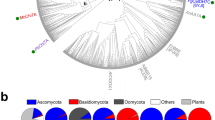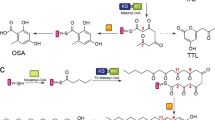Abstract
The C-branched pentose sugar d-apiose is important for plant cell wall development. Its biosynthesis as urdine diphosphate-d-apiose (UDP-d-apiose) involves decarboxylation of the UDP-d-glucuronic acid precursor coupled with pyranosyl-to-furanosyl sugar ring contraction. This unusual multistep reaction is catalysed in a single active site by UDP-d-apiose/UDP-d-xylose synthase (UAXS). Here we decipher the UAXS catalytic mechanism on the basis of crystal structures of the enzyme (which is from Arabidopsis thaliana), molecular dynamics simulations that are expanded by hybrid quantum mechanics/molecular mechanics calculations and mutational mechanistic analyses. Our studies show how UAXS uniquely integrates a classical catalytic cycle of oxidation and reduction by a tightly bound nicotinamide co-enzyme with retroaldol/aldol chemistry for the sugar ring contraction. We further demonstrate that decarboxylation occurs only after the sugar ring opening and identify that the thiol group of Cys100 steers the sugar skeleton rearrangement by proton transfer to and from C3′. The mechanistic features of UAXS highlight the evolutionary expansion of the basic catalytic apparatus of short-chain dehydrogenases/reductases for functional versatility in sugar biosynthesis.
This is a preview of subscription content, access via your institution
Access options
Access Nature and 54 other Nature Portfolio journals
Get Nature+, our best-value online-access subscription
$29.99 / 30 days
cancel any time
Subscribe to this journal
Receive 12 digital issues and online access to articles
$119.00 per year
only $9.92 per issue
Buy this article
- Purchase on Springer Link
- Instant access to full article PDF
Prices may be subject to local taxes which are calculated during checkout






Similar content being viewed by others
References
Picmanova, M. & Moller, B. L. Apiose: one of nature’s witty games. Glycobiology 26, 430–442 (2016).
Smith, J. et al. Functional characterization of UDP-apiose synthases from bryophytes and green algae provides insight into the appearance of apiose-containing glycans during plant evolution. J. Biol. Chem. 291, 21434–21447 (2016).
Carter, M. S. et al. Functional assignment of multiple catabolic pathways for d-apiose. Nat. Chem. Biol. 14, 696–705 (2018).
Smith, J. A. & Bar-Peled, M. Synthesis of UDP-apiose in bacteria: the marine phototroph Geminicoccus roseus and the plant pathogen Xanthomonas pisi. PLoS One 12, e0184953 (2017).
Matsunaga, T. et al. Occurrence of the primary cell wall polysaccharide rhamnogalacturonan II in pteridophytes, lycophytes, and bryophytes. Implications for the evolution of vascular plants. Plant Physiol. 134, 339–351 (2004).
Molhoj, M., Verma, R. & Reiter, W. D. The biosynthesis of the branched-chain sugar d-apiose in plants: functional cloning and characterization of a UDP-d-apiose/UDP-d-xylose synthase from Arabidopsis. Plant J. 35, 693–703 (2003).
Ndeh, D. et al. Complex pectin metabolism by gut bacteria reveals novel catalytic functions. Nature 544, 65–70 (2017).
Kim, M., Kang, S. & Rhee, Y. H. De novo synthesis of furanose sugars: catalytic asymmetric synthesis of apiose and apiose-containing oligosaccharides. Angew. Chem. Int. Ed. 55, 9733–9737 (2016).
Picken, J. M. & Mendicino, J. The biosynthesis of d-apiose in Lemna minor. J. Biol. Chem. 242, 1629–1634 (1967).
Sandermann, H. Jr., Tisue, G. T. & Grisebach, H. Biosynthesis of d-apiose. IV. Formation of UDP-apiose from UDP-d-glucuronic acid in cell-free extracts of parsley (Apium petroselinum L.) and Lemna minor. Biochim. Biophys. Acta 165, 550–552 (1968).
Choi, S. H., Ruszczycky, M. W., Zhang, H. & Liu, H. W. A fluoro analogue of UDP-α-d-glucuronic acid is an inhibitor of UDP-α-d-apiose/UDP-α-d-xylose synthase. Chem. Commun. 47, 10130–10132 (2011).
Choi, S. H. et al. Analysis of UDP-d-apiose/UDP-d-xylose synthase-catalyzed conversion of UDP-d-apiose phosphonate to UDP-d-xylose phosphonate: implications for a retroaldol-aldol mechanism. J. Am. Chem. Soc. 134, 13946–13949 (2012).
Eixelsberger, T. et al. Isotope probing of the UDP-apiose/UDP-xylose synthase reaction: evidence of a mechanism via a coupled oxidation and aldol cleavage. Angew. Chem. Int. Ed. 56, 2503–2507 (2017).
Mendicino, J. & Abouissa, H. Conversion of UDP-d-glucuronic acid to UDP-d-apiose and UDP-d-xylose by an enzyme isolated from Lemna minor. Biochim. Biophys. Acta 364, 159–172 (1974).
Kelleher, W. J. & Grisebach, H. Hydride transfer in the biosynthesis of uridine diphospho-apiose from uridine diphospho-d-glucuronic acid with an enzyme preparation of Lemna minor. Eur. J. Biochem. 23, 136–142 (1971).
Baron, D. & Grisebach, H. Further studies on the mechanism of action of UDP‐apiose/UDP‐xylose synthase from cell cultures of parsley. FEBS J. 38, 153–159 (1973).
Gebb, C., Baron, D. & Grisebach, H. Spectroscopic evidence for the formation of a 4-keto intermediate in the UDP-apiose/UDP-xylose synthase reaction. Eur. J. Biochem. 54, 493–498 (1975).
Kelleher, W. J., Baron, D., Ortmann, R. & Grisebach, H. Proof for the origin of the branch hydroxymethyl carbon of d-apiose from carbon 3 of d-glucuronic acid. FEBS Lett 22, 203–204 (1972).
Guyett, P., Glushka, J., Gu, X. & Bar-Peled, M. Real-time NMR monitoring of intermediates and labile products of the bifunctional enzyme UDP-apiose/UDP-xylose synthase. Carbohydr. Res. 344, 1072–1078 (2009).
Persson, B. et al. The SDR (short-chain dehydrogenase/reductase and related enzymes) nomenclature initiative. Chem. Biol. Interact. 178, 94–98 (2009).
Kavanagh, K. L., Jornvall, H., Persson, B. & Oppermann, U. Medium- and short-chain dehydrogenase/reductase gene and protein families: the SDR superfamily: functional and structural diversity within a family of metabolic and regulatory enzymes. Cell. Mol. Life Sci. 65, 3895–3906 (2008).
Jornvall, H. et al. Short-chain dehydrogenases/reductases (SDR). Biochemistry 34, 6003–6013 (1995).
Filling, C. et al. Critical residues for structure and catalysis in short-chain dehydrogenases/reductases. J. Biol. Chem. 277, 25677–25684 (2002).
Thibodeaux, C. J., Melancon, C. E. & Liu, H. W. Natural-product sugar biosynthesis and enzymatic glycodiversification. Angew. Chem. Int. Ed. 47, 9814–9859 (2008).
Eixelsberger, T. et al. Structure and mechanism of human UDP-xylose synthase: evidence for a promoting role of sugar ring distortion in a three-step catalytic conversion of UDP-glucuronic acid. J. Biol. Chem. 287, 31349–31358 (2012).
Bar-Peled, M., Griffith, C. L. & Doering, T. L. Functional cloning and characterization of a UDP-glucuronic acid decarboxylase: the pathogenic fungus Cryptococcus neoformans elucidates UDP-xylose synthesis. Proc. Natl Acad. Sci. USA. 98, 12003–12008 (2001).
Gatzeva-Topalova, P. Z., May, A. P. & Sousa, M. C. Crystal structure of Escherichia coli ArnA (PmrI) decarboxylase domain. A key enzyme for lipid A modification with 4-amino-4-deoxy-l-arabinose and polymyxin resistance. Biochemistry 43, 13370–13379 (2004).
Polizzi, S. J. et al. Human UDP-α-d-xylose synthase and Escherichia coli ArnA conserve a conformational shunt that controls whether xylose or 4-keto-xylose is produced. Biochemistry 51, 8844–8855 (2012).
Matern, U. & Grisebach, H. UDP-apiose/UDP-xylose synthase. Subunit composition and binding studies. Eur. J. Biochem. 74, 303–312 (1977).
Gatzeva-Topalova, P. Z., May, A. P. & Sousa, M. C. Structure and mechanism of ArnA: conformational change implies ordered dehydrogenase mechanism in key enzyme for polymyxin resistance. Structure 13, 929–942 (2005).
Pfeiffer, M. et al. A parsimonious mechanism of sugar dehydration by human GDP-mannose-4,6-dehydratase. ACS Catal. 9, 2962–2968 (2019).
Gerratana, B., Cleland, W. W. & Frey, P. A. Mechanistic roles of Thr134, Tyr160, and Lys 164 in the reaction catalyzed by dTDP-glucose 4,6-dehydratase. Biochemistry 40, 9187–9195 (2001).
Kirschner, K. N. et al. GLYCAM06: a generalizable biomolecular force field. Carbohydrates. J. Comput. Chem. 29, 622–655 (2008).
Berger, E. et al. Acid-base catalysis by UDP-galactose 4-epimerase: correlations of kinetically measured acid dissociation constants with thermodynamic values for tyrosine 149. Biochemistry 40, 6699–6705 (2001).
Baron, D. & Grisebach, H. Further studies on mechanism of action of UDP-apiose/UDP-xylose synthase from cell-cultures of parsley. Eur. J. Biochem. 38, 153–159 (1973).
Fujimori, T. et al. Practical preparation of UDP-apiose and its applications for studying apiosyltransferase. Carbohydr. Res. 477, 20–25 (2019).
Acknowledgements
The contributions of P. Scudieri (enzyme characterization), A. Lepak (UDP-apiose HPLC assay) and J. Coines (analysis of MD trajectories) are gratefully acknowledged. This work was supported by the Federal Ministry of Science, Research and Economy (BMWFW), the Federal Ministry of Traffic, Innovation and Technology (bmvit), the Styrian Business Promotion Agency SFG, the Standortagentur Tirol, and the Government of Lower Austrian and Business Agency Vienna through the COMET-funding programme managed by the Austrian Research Promotion Agency FFG. Funding from the Austrian Science Funds (FWF; I-3247 to B.N. and A.J.E.B.) and by the Italian Ministry of Education, University and Research (MIUR) (Dipartimenti di Eccellenza Program (2018–2022)—Department of Biology and Biotechnology ‘L. Spallanzani’ University of Pavia) is acknowledged.
Author information
Authors and Affiliations
Contributions
S.S. performed protein crystallization and determined the structures. K.D.D., M.P. and C.R. performed MD simulations and QM calculations, and, with A.J.E.B., analysed the data. A.D., with F. de G. and A.J.E.B., designed enzyme variants and performed biochemical characterization. A.D., A.J.E.B. and H.W. performed the NMR analyses. A.J.E.B. performed substrate synthesis and product isolation. A.J.E.B. and A.D. performed the mechanistic analyses. B.N. and A.M. designed and supervised the research. The manuscript was written with contributions from all authors. B.N., A.D., A.M. S.S. and A.J.E.B. wrote the paper.
Corresponding authors
Ethics declarations
Competing interests
The authors declare no competing interests.
Additional information
Publisher’s note Springer Nature remains neutral with regard to jurisdictional claims in published maps and institutional affiliations.
Supplementary information
Supplementary Information
Supplementary Methods, Table 1, Figs. 1–47 and references
Supplementary Video 1
Motions of the UAXS active site during MD simulations (replica 1)
Supplementary Video 2
Motions of the UAXS active site during MD simulations (replica 2)
Supplementary Data 1
Initial coordinates for replica 1
Supplementary Data 2
Initial coordinates for replica 2
Supplementary Data 3
Final coordinates after 300 ns of MD simulations for replica 1
Supplementary Data 4
Final coordinates after 300 ns of MD simulations for replica 2
Supplementary Data 5
QM/MM optimized geometry of the QM region of the QM/MM calculation in the XYZ file format for a snapshot taken from the MD of replica 1
Supplementary Data 6
QM/MM optimized geometry of the QM region of the QM/MM calculation in the XYZ file format, the snapshot is taken from the MD for replica 2
Supplementary Data 7
Snapshot from replica 1 used for QM/MM calculations, it represents the Michaelis complex before QM/MM optimization
Supplementary Data 8
Snapshot from replica 2 used for QM/MM calculations, it represents the complex before QM/MM optimization
Supplementary Data 9
QM/MM optimized geometry of the entire complex including the QM and MM region from the QM/MM calculation in the XYZ file format, the snapshot was taken from the MD of replica 1.
Supplementary Data 10
QM/MM optimized geometry of the entire complex including the QM and MM region of the QM/MM calculation in the XYZ file format, the snapshot was taken from the MD of replica 2
Rights and permissions
About this article
Cite this article
Savino, S., Borg, A.J.E., Dennig, A. et al. Deciphering the enzymatic mechanism of sugar ring contraction in UDP-apiose biosynthesis. Nat Catal 2, 1115–1123 (2019). https://doi.org/10.1038/s41929-019-0382-8
Received:
Accepted:
Published:
Issue Date:
DOI: https://doi.org/10.1038/s41929-019-0382-8
This article is cited by
-
Insights into the missing apiosylation step in flavonoid apiosides biosynthesis of Leguminosae plants
Nature Communications (2023)



